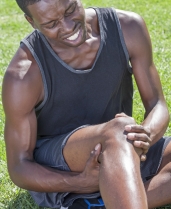What is Patellofemoral Pain Syndrome?
Tuesday, October 14, 2014 - 15:55

Patellofemoral pain is a common complaint and is one of the most prevalent knee disorders. Essentially it means at athlete has pain around and under the patella, or knee cap. Almost anyone can get it, but it particularly affects runners, cyclists and hikers as well as office workers that end up sitting for long periods of time.
Another name for this condition is movie-goers knee because of the tendency of the condition to cause pain after sitting for a long period of time.
Symptoms may include:
- Aching around the patella
- Pain worsens with stairs – up or down, walking, running, jumping and squatting
- Pain worsens with long periods of sitting
- Clicks, pops, grinding or swelling (though some clicking and grinding under the patella is normal)
What causes patellofemoral pain?
- Overuse of the knee, particularly at times of increased training.
- Lack of proper stretching pre/post exercise.
- Weak quadriceps (front thigh) muscles are recognized to be a common cause of patellofemoral pain and strengthening these muscles are one of the first things a therapist can work on with you.
- Muscle imbalances: If one side of the quadriceps muscles pulls harder than the other side, then the patella may not glide properly and can rub on one side, causing pain.
- Other common causes are thought to be weak hip muscles, weak core (stomach and back) muscles, tight muscles in the hip and thigh, and flat or pronated feet.
What can I expect from physiotherapy?
Since every person is different, most therapists will come up with a treatment plan that works best for you and your specific needs. Many times therapy consists of exercises that can be performed at home – usually only taking approximately 20 minutes a day. For example, you may be taught to do exercises which strengthen the inner side of the quadriceps muscle. You may also be taught exercises to stretch tight ligaments. While guidance from a physical therapist is useful, patients need to stick to their individualized treatment plan and should not expect overnight success. Many patients will improve eventually, but it could take up to six weeks or longer and the pain may re-occur in the future.
Despite the common occurrence of patellofemoral pain, there is very little, strong evidence-based studies that prove the effectiveness of a specific treatment. Most of the time, patellofemoral pain is managed with various methods including one or a combination of strength, flexibility, endurance and functional training on an on-going basis to decrease the chances of the pain recurring. Since patellofemoral pain usually coincides with overuse injuries, it is recommended that a person suffering from this type of pain gradually increases the training load over time to minimize further damage.
References from the SIRC Collection:
DE MARCHE BALDON R, SERRÃO F, SILVA R, PIVA S. Effects of Functional Stabilization Training on Pain, Function, and Lower Extremity Biomechanics in Women With Patellofemoral Pain: A Randomized Clinical Trial. Journal Of Orthopaedic & Sports Physical Therapy. April 2014;44(4):240-251.
Freedman S, Brody L, Rosenthal M, Wise J. Short-Term Effects of Patellar Kinesio Taping on Pain and Hop Function in Patients With Patellofemoral Pain Syndrome. Sports Health: A Multidisciplinary Approach. July 2014;6(4):294-300.
Long-Rossi F, Salsich G. Pain and hip lateral rotator muscle strength contribute to functional status in females with patellofemoral pain. Physiotherapy Research International. March 2010;15(1):57-64.
Mason M, Keays S, Newcombe P. The Effect of Taping, Quadriceps Strengthening and Stretching Prescribed Separately or Combined on Patellofemoral Pain. Physiotherapy Research International. June 2011;16(2):109-119.
Naseri N, Pourkazemi F. Difference in knee joint position sense in athletes with and without patellofemoral pain syndrome. Knee Surgery, Sports Traumatology, Arthroscopy. October 2012;20(10):2067-2072.